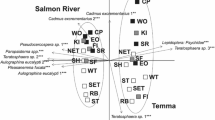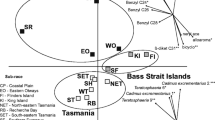Abstract
Within the area of community genetics there is an expanding volume of literature demonstrating how within-species genetic variation in temperate trees can have important effects on structuring animal and plant communities. The influence of intraspecific genetic variation on associated communities in relatively more complex ecosystems is only starting to be appreciated. Within tropical forests, epiphytic bromeliad plants often grow high in the canopy and create unique nutrient-rich microhabitats on which many invertebrate and vertebrate species depend. We investigated the influence of within-species genetic variation in the bromeliad Aechmea bracteata on the invertebrate microhabitat community. We found that more genetically similar bromeliad plants were host to more similar communities of juvenile-stage invertebrates, but not adult invertebrates. We discuss possible mechanisms for this, including differential survival and active female oviposition choice. Our work shows that the impact of within-species genetic variation on associated ecological communities may be more general than previously considered. These results agree with recent research suggesting that within-species genetic variation may perform a supporting ecosystem service for maintaining community and ecological processes.



Similar content being viewed by others
References
Anderson SS, McCrea KD, Abrahamson WG, Hartzel LM (1989) Host genotype choice by the ball gallmaker Eurosta solidaginis (Diptera: Tephritidae). Ecology 70:1048–1054
Araújo VA, Melo SK, Araújo AP, Gomes ML, Carneiro MA (2007) Relationship between invertebrate fauna and bromeliad size. Braz J Biol 67:611–617
Armbruster P, Hutchinson RA, Cotgreave P (2002) Factors influencing community structure in a South American tank bromeliad fauna. Oikos 96:225–234
Bailey JK (2011) From genes to ecosystems: a genetic basis to ecosystem services. Popul Ecol 53:47–52
Bailey JK, Schweitzer JA, Rehill BJ, Lindroth RL, Martinsen GD, Whitham TG (2004) Beavers as molecular geneticists: a genetic basis to the foraging of an ecosystem engineer. Ecology 85:603–608. doi:10.1890/03-3049
Bangert RK, Turek RJ, Martinsen GD, Wimp GM, Bailey JK, Whitham TG (2005) Benefits of conservation of plant genetic diversity to arthropod diversity. Conserv Biol 19:379
Bangert RK, Turek RJ, Rehill B, Wimp GM, Schweitzer JA, Allan GJ, Bailey JK, Martinsen GD, Keim P et al (2006) A genetic similarity rule determines arthropod community structure. Mol Ecol 15:1379–1391. doi:10.1111/j.1365-294X.2005.02749.x
Bangert RK, Lonsdorf EV, Wimp GM, Shuster SM, Fischer D, Schweitzer JA, Allan GJ, Bailey JK, Whitham TG (2008) Genetic structure of a foundation species: scaling community phenotypes from the individual to the region. Heredity 100:121–131. doi:10.1038/sj.hdy.6800914
Bentley MD, Day JF (1989) Chemical ecology and behavioral aspects of mosquito oviposition. Annu Rev Entomol 34:401–421
Bray JR, Curtis JT (1957) An ordination of the upland forest communities of Southern Wisconsin. Ecol Monogr 27:325–349
Carius HJ, Little TJ, Ebert D (2001) Genetic variation in a host-parasite association: potential for coevolution and frequency-dependent selection. Evolution 55:1136–1145
Chase MW, Hills HH (1991) Silica gel: an ideal material for field preservation of leaf samples for DNA studies. Taxonomy 40:215–220
Diesel R, Schuh M (1993) Maternal care in the bromeliad crab Metopaulias depressus (Decapoda): maintaining oxygen, pH and calcium levels optimal for the larvae. Behav Ecol Sociobiol 32:11–15
Dobson A, Crawley M (1994) Pathogens and the structure of plant communities. Trends Ecol Evol 9:393–398
Doyle JJ, Doyle JL (1987) A rapid DNA isolation procedure for small quantities of fresh leaf tissue. Phytochem Bull 19:11–15
Dungey HS, Potts BM, Whitham TG, Li HF (2000) Plant genetics affects arthropod community richness and composition: evidence from a synthetic eucalypt hybrid population. Evolution 54:1938–1946
Frank JH, Lounibos LP (2009) Insects and allies associated with bromeliads: a review. Terr Arthropod Rev 1:125–153. doi:10.1163/187498308X414742
Fritz RS, Price PW (1988) Genetic variation among plants and insect community structure: willows and sawflies. Ecology 69:845–856
Gaylord ES, Preszler RW, Boecklen WJ (1996) Interactions between host plants, endophytic fungi, and a phytophagous insect in an oak (Quercus grisea × Q. gambelii) hybrid zone. Oecologia 105:336–342
Glinwood R, Ahmed E, Qvarfordt E, Ninkovic V (2011) Olfactory learning of plant genotypes by a polyphagous insect predator. Oecologia 166:637–647. doi:10.1007/s00442-010-1892-x
Haloin JR, Strauss SY (2008) Interplay between ecological communities and evolution: review of feedbacks from microevolutionary to macroevolutionary scales. Ann NY Acad Sci 1133:87–125. doi:10.1196/annals.1438.003
Hersch-Green EI, Turley NE, Johnson MT (2011) Community genetics: what have we accomplished and where should we be going? Philos Trans R Soc Lond B 366:1453–1460. doi:10.1098/rstb.2010.0331
Hooper DU, Chapin FS III, Ewel JJ, Hector A, Inchausti P, Lavorel S, Lawton JH, Lodge DM, Loreau M et al (2005) Effects of biodiversity on ecosystem functioning: a consensus of current knowledge. Ecol Monogr 75:3–35
Iason GR, Lennon JJ, Pakeman RJ, Thoss V, Beaton JK, Sim DA, Elston DA (2005) Does chemical composition of individual Scots pine trees determine the biodiversity of their associated ground vegetation? Ecol Lett 8:364–369. doi:10.1111/j.1461-0248.2005.00732.x
Ives AR, Cardinale BJ, Snyder WE (2005) A synthesis of subdisciplines: predator–prey interactions, and biodiversity and ecosystem functioning. Ecol Lett 8:102–116
Johnson MTJ, Lajeunesse MJ, Agrawal AA (2006) Additive and interactive effects of plant genotypic diversity on arthropod communities and plant fitness. Ecol Lett 9:24–34
Krugel P, Richter S (1995) Syncope antenori—A Bromeliad Breeding Frog with Free-Swimming, Nonfeeding Tadpoles (Anura, Microhylidae). Copeia 1995:955–963
Laessle AM (1961) A micro-limnological study of Jamaican bromeliads. Ecology 42:499–517
Larsen TH, Williams NM, Kremen C (2005) Extinction order and altered community structure rapidly disrupt ecosystem functioning. Ecol Lett 8:538–547
Luck GW, Daily GC, Ehrlich PR (2003) Population diversity and ecosystem services. Trends Ecol Evol 18:331–336
Muller MS, McWilliams SR, Podlesak D, Donaldson JR, Bothwell HM, Lindroth RL (2006) Tri-trophic effects of plant defenses: chickadees consume caterpillars based on host leaf chemistry. Oikos 114:507–517
Nadkarni N (1994) Diversity of species and interactions in the upper tree canopy of forest ecosystems. Am Zool 34:70–78
Reusch TB, Ehlers A, Hämmerli A, Worm B (2005) Ecosystem recovery after climatic extremes enhanced by genotypic diversity. Proc Natl Acad Sci USA 102:2826–2831. doi:10.1073/pnas.0500008102
Richardson BA (1999) The bromeliad microcosm and the assessment of faunal diversity in a Neotropical forest. Biotropica 31:321–336
Rosenberg MS, Anderson CD (2011) PASSaGE: Pattern analysis, spatial statistics and geographic exegesis. Version 2. Methods Ecol Evol 2:229–232
Rowntree JK, Shuker DM, Preziosi RF (2011) Forward from the crossroads of ecology and evolution. Philos Trans R Soc Lond B 366:1322–1328
Schweitzer JA, Rehill BJ, Martinsen GD, Lindroth RL, Keim P, Whitham TG (2004) Genetically based trait in a dominant tree affects ecosystem processes. Ecol Lett 7:127–134. doi:10.1111/j.1461-0248.2003.00562.x
Service P (1984) Genotypic interactions in an aphid-host plant relationship: Uroleucon rudbeckiae and Rudbeckia laciniata. Oecologia 61:271–276
Shaffer ML (1981) Minimum population sizes for species conservation. Bioscience 31:131–134
Srivastava DS (2006) Habitat structure, trophic structure and ecosystem function: interactive effects in a bromeliad–insect community. Oecologia 149:493–504. doi:10.1007/s00442-006-0467-3
Stuntz S, Zielger C, Simon U, Zotz G (2002) Diversity and structure of the arthropod fauna within three canopy epiphyte species in central Panama. J Trop Ecol 18:161–176
Tack AJM, Johnson MTJ, Roslin T (2011) Sizing up community genetics: it’s a matter of scale. Oikos. doi:10.1111/j.1600-0706.2011.19926.x
Vellend M, Geber MA (2005) Connections between species diversity and genetic diversity. Ecol Lett 8:767–781
Vos P, Hogers R, Bleeker M, Reijans M, Van De Lee T, Hornes M, Frijters A, Pot J, Peleman J et al (1995) AFLP: a new technique for DNA fingerprinting. Nucleic Acids Res 23:4407–4414
Wake DB (1987) Adaptive radiation of salamanders in middle American cloud forests. Ann Mo Bot Gard 74:242–264
Wennstrom A, Hjulstrom LN, Hjalten J, Julkunen-Tiitto R (2010) Mother really knows best: host choice of adult phytophagous insect females reflects a within-host variation in suitability as larval food. Chemoecology 20:35–42
Whitham TG, Young WP, Martinsen GD, Gehring CA, Schweitzer JA, Shuster SM, Wimp GM, Fischer DG, Bailey JK et al (2003) Community and ecosystem genetics: a consequence of the extended phenotype. Ecology 84:559–573
Whitham TG, Bailey JK, Schweitzer JA, Shuster SM, Bangert RK, LeRoy CJ, Lonsdorf EV, Allan GJ, DiFazio SP et al (2006) A framework for community and ecosystem genetics: from genes to ecosystems. Nat Rev Genet 7:510–523. doi:10.1038/nrg1877
Yanoviak SP (2001) Container color and location affect macroinvertebrate community structure in artificial treeholes in Panama. Fla Entomol 84:265–271
Zuur AF, Ieno EN, Smith GM (2007) Analysing ecological data. Springer, New York
Zytynska SE, Preziosi RF (2011) Genetic interactions influence host preference and performance in a plant-insect system. Evol Ecol 25:1321–1333. doi:10.1007/s10682-011-9493-7
Zytynska SE, Fleming S, Tetard-Jones C, Kertesz MA, Preziosi RF (2010) Community genetic interactions mediate indirect ecological effects between a parasitoid wasp and rhizobacteria. Ecology 91:1563–1568
Zytynska SE, Fay MF, Penny D, Preziosi RF (2011) Genetic variation in a tropical tree species influences the associated epiphytic plant and invertebrate communities in a complex forest ecosystem. Philos Trans R Soc Lond B 366:1329–1336
Acknowledgments
We thank Waldo Etherington, Adam van Casteren, Larissa Chambers, and Joaquín Urrutia for tree-climbing and bromeliad collection. We also want to thank Jennifer Rowntree and the many ‘Belize 2008–2010’ field course students who were involved in invertebrate community sampling. In addition, we thank Alice Kay, Nathan Truelove, and Lisa Andrejczak for assistance with molecular work. This work has been funded under the HECBP in cooperation between Damascus University and The British Council.
Author information
Authors and Affiliations
Corresponding author
Additional information
Communicated by Jason Tylianakis.
Rights and permissions
About this article
Cite this article
Zytynska, S.E., Khudr, M.S., Harris, E. et al. Genetic effects of tank-forming bromeliads on the associated invertebrate community in a tropical forest ecosystem. Oecologia 170, 467–475 (2012). https://doi.org/10.1007/s00442-012-2310-3
Received:
Accepted:
Published:
Issue Date:
DOI: https://doi.org/10.1007/s00442-012-2310-3




